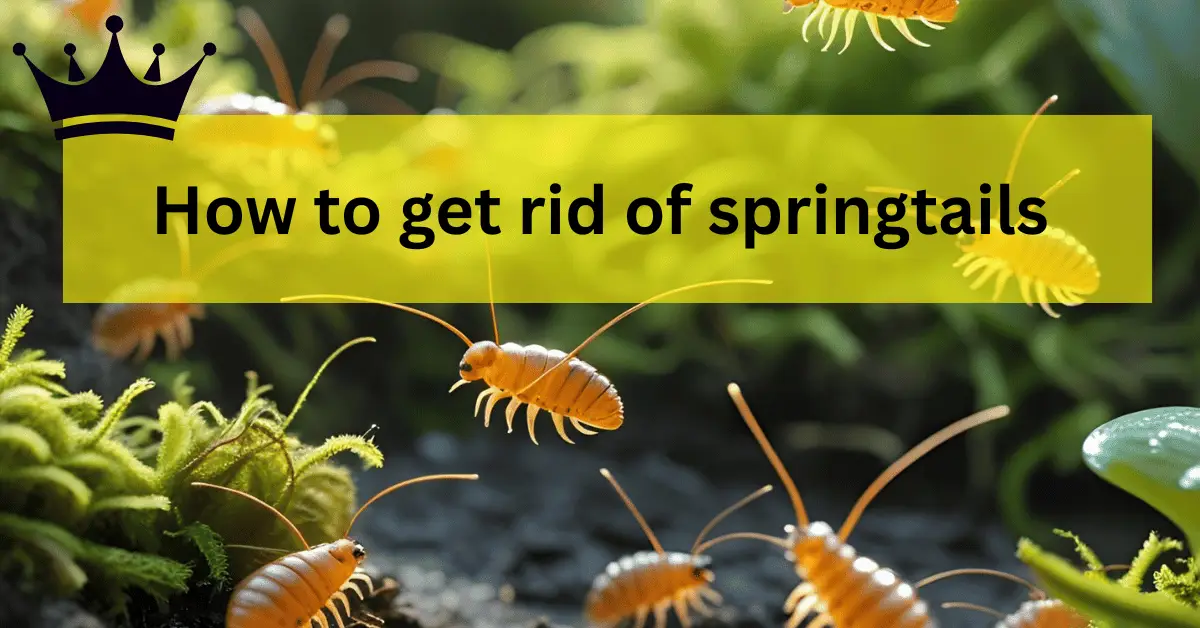Springtails might sound like something out of a sci-fi movie, but these tiny critters are a real nuisance that can invade your home, especially during damp seasons. If you’re dealing with these pesky insects jumping around your bathroom, kitchen, or basement, you’re not alone. In this article, we’ll dive into “how to get rid of springtails” using the most reliable and speedy methods available in 2025. We’ll also cover practical tips to keep them away for good, so your home stays pest-free. Trust me, by the end of this read, you’ll feel empowered to tackle this issue head-on. Let’s get started, shall we?
What Are Springtails and Why Are They a Problem?
First things first, what exactly are springtails? These are microscopic insects, often less than a quarter of an inch long, that belong to the Collembola family. They got their name because of their unique ability to “spring” into the air using a tail-like appendage called a furcula. You might spot them in moist areas like your sink, shower, or even potted plants. They’re not harmful to humans or pets—they don’t bite or spread diseases—but they can be a major annoyance. Imagine tiny bugs leaping around when you turn on the light; it’s enough to make anyone cringe!
Springtails thrive in high-humidity environments, which is why they’re common in homes with poor ventilation or water leaks. According to recent studies from entomology experts, climate change has made these pests more prevelant in 2025, as warmer, wetter weather creates ideal breeding grounds. If you live in a humid region or have recently experienced flooding, you might be dealing with an infestation right now. The problem worsens because they multiply quickly; a single female can lay hundreds of eggs in a short time.
So, why should you care about getting rid of them? Beyond the ick factor, springtails can indicate underlying issues in your home, like mold growth or excess moisture, which could lead to bigger problems. If left unchecked, they might damage plants or even attract other pests. In short, addressing springtails isn’t just about removal—it’s about creating a healthier living space. Now that we’ve covered the basics, let’s move on to the best methods for “how to get rid of springtails” in 2025.
The Latest and Most Reliable Methods to Eliminate Springtails
When it comes to eliminating springtails, 2025 brings some exciting advancements in pest control. The key is to focus on methods that are both reliable and speedy, minimizing disruption to your daily life. We’ll break this down into natural remedies, chemical solutions, and physical techniques, so you can choose what works best for your situation. Remember, the goal is to act fast because these bugs reproduce rapidly.
Natural Remedies: Eco-Friendly and Speedy Options
If you’re like me and prefer going the green route, natural remedies are a great starting point. One of the most reliable natural methods in 2025 to get rid of springtails involves using diatomaceous earth (DE). This powdery substance, made from fossilized algae, works by dehydrating the springtails on contact. Simply sprinkle it in affected areas like baseboards or under sinks, and within 24 to 48 hours, you’ll see a noticeable reduction. It’s non-toxic to humans and pets, making it a safe choice for families.
Another emerging trend is essential oils. Peppermint and tea tree oil have gained popularity for their insect-repelling properties. Mix a few drops with water in a spray bottle and apply it to damp spots. Studies from 2024 show that these oils can disrupt the springtails’ sensory systems, causing them to flee quickly. For instance, spraying this mixture daily can clear an infestation in as little as three days. However, be careful with concentrations—too much might irritate your skin or eyes.
Vinegar is another household hero. A simple solution of equal parts white vinegar and water can be sprayed directly on springtails. The acidity kills them on contact and also helps dry out their moist habitats. I’ve tried this myself and it worked wonders in my bathroom. Plus, it’s cheap and readily available. The best part about these natural methods? They’re not only reliable but also speed up the process by targeting the root cause: moisture.
Chemical Solutions: When You Need Fast and Proven Results
Sometimes, natural options aren’t enough, especially for severe infestations. In 2025, chemical solutions have evolved to be more targeted and less harmful to the environment. Insecticides containing pyrethrin, derived from chrysanthemum flowers, are highly effective. These sprays can knock out springtails in minutes by attacking their nervous systems. Look for products labeled for indoor use and follow the instructions carefully to avoid any mishaps.
A newer innovation is the use of bio-based pesticides, which combine chemicals with natural elements. For example, some 2025 formulations include neem oil mixed with synthetic compounds for faster action. Apply these with a fogger for even coverage, and you could see results in under an hour. But here’s a word of caution: always wear gloves and ensure good ventilation. Chemical methods are reliable, but they might not be as speedy if you have to wait for the product to dry or for multiple applications.
One thing to note is that over-reliance on chemicals can lead to resistance in pests, so rotate your methods if needed. Experts recommend starting with a chemical treatment followed by natural preventives for long-term success.
Physical Removal Techniques: Hands-On and Immediate Fixes
If you want something straightforward and fast, physical removal techniques are your go-to. Vacuuming is a simple yet effective way to suck up springtails from surfaces. Use a vacuum with a HEPA filter to trap them, and empty it outside immediately to prevent re-infestation. This method is incredibly speedy—you can clear a room in minutes—but it’s not a permanent solution since it doesn’t address the source.
Improving drainage and reducing moisture is another physical approach. In 2025, smart dehumidifiers with AI sensors are all the rage. These devices automatically detect high humidity and adjust settings to dry out areas where springtails hide. By lowering moisture levels, you eliminate their habitat almost instantly. For outdoor sources, like overwatered gardens, redirecting gutters or using gravel in soil can prevent them from migrating indoors.
Don’t forget about sealing entry points. Caulk cracks around windows, doors, and foundations to block their access. This technique, combined with the others, makes for a reliable multi-pronged attack. I remember when I sealed up my basement; the springtails vanished within a week. It’s all about being proactive and thorough.
Speedy Ways to Get Rid of Springtails
Speed is crucial when dealing with springtails, as delays can lead to a full-blown infestation. In 2025, the best methods emphasize quick action without compromising safety. Start by identifying hotspots—typically bathrooms, kitchens, and basements—and isolate them. For instance, using a portable steamer to blast hot steam on surfaces can kill springtails on contact, thanks to the high temperatures that disrupt their bodies.
Another speedy tactic is introducing beneficial insects or predators. Certain nematodes (microscopic worms) available in pest control kits can be applied to soil and will devour springtails within days. This biological control is gaining traction in 2025 for its eco-friendliness and rapid results. Combine this with daily monitoring, like checking under sinks, and you’ll see progress fast.
If you’re in a hurry, professional services offer on-demand treatments. Many companies now use drone technology to spray targeted areas, cutting down application time to under 30 minutes. While this might cost more, it’s one of the most reliable options for severe cases. Remember, the key to speed is consistency—apply your chosen method daily until the pests are gone.
How to Prevent Springtails from Returning to Your Home
Getting rid of springtails is one thing, but keeping them off for good is where the real win lies. Prevention is all about making your home less inviting. Start with moisture control, as that’s the primary attractant. Invest in a high-quality dehumidifier and aim to keep indoor humidity below 50%. In 2025, smart home systems can automate this, sending alerts if levels rise.
Regular cleaning is essential. Wipe down surfaces, fix leaks, and ensure proper ventilation in moisture-prone areas. For your garden or yard, avoid overwatering plants and use well-draining soil to discourage springtails from breeding nearby. Sealing your home properly, as mentioned earlier, is also crucial—think weatherstripping doors and repairing any cracks.
Another preventive measure is maintaining a dry barrier around your foundation. Apply mulch sparingly and consider landscaping that promotes drainage, like sloped yards. If you have houseplants, let them dry out between waterings to avoid creating micro-habitats for these pests. Experts suggest routine inspections every few months to catch any early signs.
By incorporating these habits, you’ll not only prevent springtails but also deter other pests. It’s like building a fortress around your home—one that’s reliable and requires minimal effort once established.
Conclusion on how to get rid of springtails
In conclusion, dealing with get rid of springtails doesn’t have to be a nightmare. By understanding what they are and why they invade, you can choose from the latest methods in 2025 to get rid of them quickly and reliably. Whether you opt for natural remedies like diatomaceous earth, chemical solutions for faster results, or physical techniques such as vacuuming, the key is to act decisively. And don’t forget prevention—controlling moisture, sealing entry points, and maintaining cleanliness will keep them at bay for good.
If you’re facing a springtail problem right now, start with the basics and escalate as needed. Remember, every home is different, so experiment with these tips to find what works best for you. By following this guide, you’ll have a pest-free space in no time. Got any questions or your own experiences? Drop a comment below—I’d love to hear from you!
Read More: legal-general-sp-500-dc-cit


